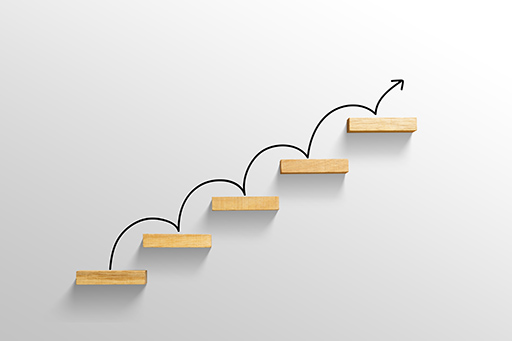3 The five-step career planning strategy

In Session 1 you were introduced to the athletic career transition model (Alfermann and Stambulova, 2007). This model suggests that athletes will either experience a successful (positive) transition or a crisis (negative) transition (Stambulova, 2017). In order to help athletes develop the coping skills required to move successfully through career transitions, frameworks such as the five-step career planning strategy (Stambulova, 2010) have been developed.
You will explore this planning strategy using the case study of Larissa, a 23 year old full time swimmer who is working through the five steps with her sport psychologist Ravi. Other athletes may work through these steps on their own or with another person such as a coach, parent or performance lifestyle advisor.
Box _unit4.4.1 Box 1 The five steps
Step 1: Create a framework
In this first step Larissa is asked to draw a timeline of her life, divided into past, present and future.
Step 2: Structure your past
Larissa then adds and describes the most important events that have happened in her life (sporting and non-sporting) to the ‘past’ section of her timeline. She identifies various events including key competitions she has won, moving away from home to train with her current coach and leaving school. Ravi asks her questions to help her think about these key events.
Step 3: Structure your present
In this third step Larissa identifies the most important aspects in her life currently. She identifies ‘sport, family and friends’ and after discussing them with Ravi ranks each of these on three different scales:
- i.the subjective importance of each aspect (e.g. how important does she feel her family are)
- ii.the time spent on each aspect (e.g. how much time does she spend with her family in a typical week), and
- iii.the stress levels associated with each aspect (e.g. how much stress do her family cause her).
The purpose of this step is to help Larissa analyse the balance she has in her life. It makes her realise that almost everything she does in her life currently is focused on swimming.
Step 4: Structure your future
Larissa is now encouraged to think about the future and consider what important events she expects to occur in different aspects of her life over the next 1, 3, 5 and 10 years and her entire life. This encourages her to identify how long she imagines her career will last and what events are most likely to be prioritised following retirement from sport.
Larissa has very clear goals for what she wants to achieve in her sport over the next 1−5 years and doesn’t expect to be competing after that. But she hasn’t put a huge amount of thought into what she might do after she stops competing, although she thinks she could be a good coach.
Step 5: Bridge your past, present and future
This step is divided into three sub-steps (5a, 5b and 5c) that Larissa works through with Ravi.
- Step 5a directs Larissa from the present to the past and gets her to focus on the successes and difficulties she faced, as well as the skills and lessons gained. This helps Larissa to identify the skills she has developed on her journey so far and reminds her of what she has achieved.
- Step 5b directs Larissa from the present to the future and asks her to develop goals and identify goal achievement strategies and potential barriers. Larissa reflects on what she needs to work on with her coach to achieve her swimming goals and also what she needs to do to become a swimming coach.
- The final step 5c moves from the future to the present and focuses on how Larissa can balance her current and future priorities. This encourages her to plan ahead as well as plan for the present. As a result, she makes a decision to look into part-time and distance learning sports coaching degrees that she could fit around her training.
Activity _unit4.4.1 Activity 3 Evaluating the five-step career plan
Having read the five-step career planning strategy in Box 1 reflect on how useful you think it would be to an athlete like Larissa. If you are an athlete yourself or if you support athletes, you may also like to reflect on how useful you think it would be to you. As you do this think about the potential strengths and weaknesses of the strategy.
Discussion
Stambulova (2010) reported that the five-step career planning strategy is perceived as effective by both athletes and practitioners.
You may have reflected that it could be a useful tool to help you or the athletes you support think about and plan for future moves. It appeared to be a useful tool to help Larissa think about her career so far and plan ahead for future transitions and life after sport. It encouraged her to start preparing now for a future career in coaching, something she hadn’t thought about until creating and discussing her timeline.
A strength of the strategy is that it can encourage an individual to start thinking about and preparing for future transitions, and this preparation can help an athlete experience a positive rather than crisis transition.
A potential limitation of the strategy is that its success depends on the skill of the person supporting the athlete to ask the right questions to help them delve deeper into their world and consider future transitions. For this reason, professionals such as performance lifestyle advisors and sport psychologists are well placed to support athletes through the five-step strategy. However, as you saw earlier, not all athletes will have access to these professionals and may instead utilise the support of another person.
So far in this session you have explored the importance of preparing for career transitions to ensure they go smoothly. In the next section you’ll look at other ways to help career transitions go smoothly.
